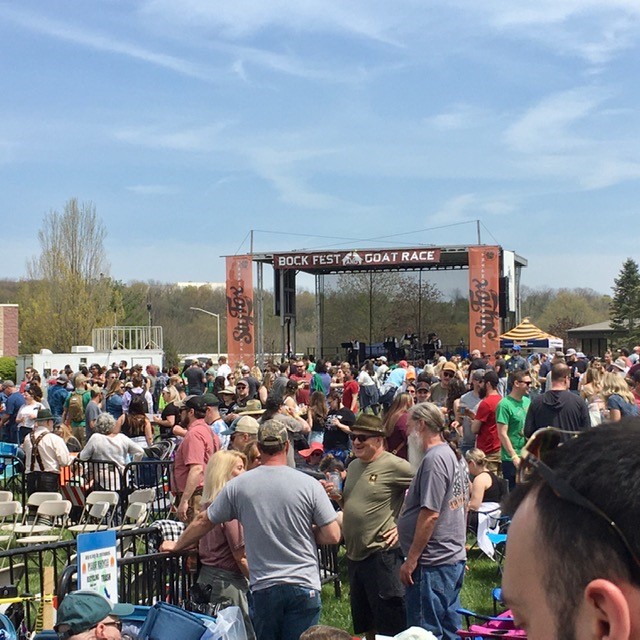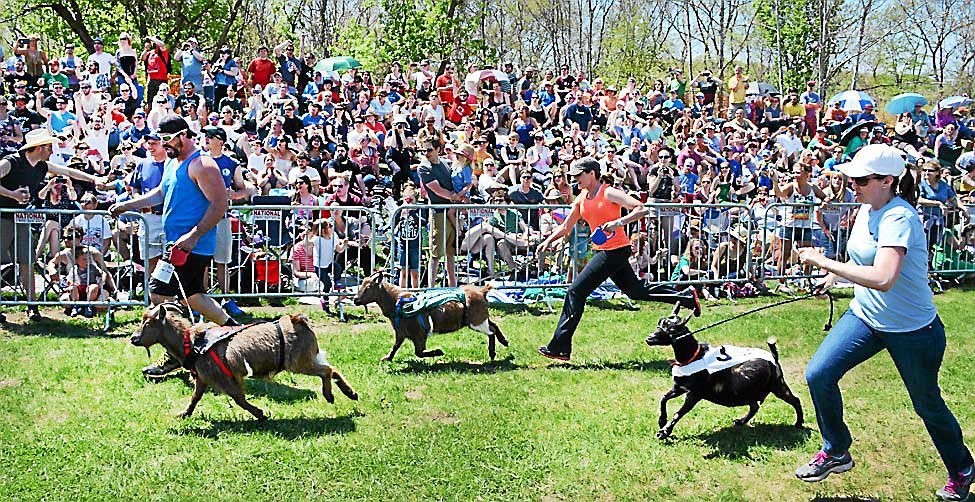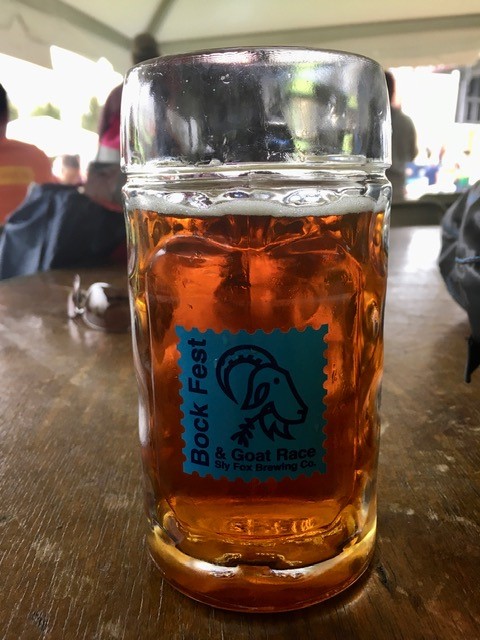By Jack Horzempa
.jpg)
I remember a story from when I was “a kid” that Bock Beer was the brown stuff they found on the bottom of the brew kettle. Why the heck they would wait till spring to ‘clean’ the brew kettle always stumped me. Well, this whole bottom of the brew kettle thing is a myth.
The way-back history of Bock beer starts in the German town of Einbeck in what was known as Lower Saxony during the time of this beer style’s brewing: 14th Century. This original Bock beer would have been dark in color since malts of that time were kilned by fire which would have caused some browning of the malt. This method of kilning would likely also have added a bit of a smoky flavor to the beer. The other attribute of this beer is that was quite strong (i.e., higher ABV).
During the 14th Century the brewing of Bock Beer in Einbeck was an interesting enterprise in that the City Council dictated how things were done. A number of burghers (i.e., middle-class/wealthier city citizens) were permitted to produce their own malt but the beer had to be brewed by a city owned brewhouse. I suppose from a brewing operation perspective this is sort of like a community-based project. The actual brewing was conducted by professional brewers who would travel with the brewhouse equipment to each of the burghers’ residences and brew the beer there with the locally produced malt. One of the city’s employees was titled the brewmaster and he had the duty and authority to supervise production and certify that the resulting beer was suitable for sale/export. A very interesting method for beer production indeed.
The beers of Einbeck were appreciated by Bavarian beer drinkers and in the early 1600’s a Bavarian brewery hired a brewer from Einbeck to brew this type of beer which was branded as “oanpock”. Later on, other types of Bock Beers were developed in Bavaria with some examples being Doppelbock (for drinking during Lent) and Maibock (for spring drinking).
There are a couple of stories here (more folklore??):
One story is that the town of Einbeck as pronounced by Bavarians comes out like “Einbock” and according to Google translate the word ziegenbock = Billy Goat.
The other story is that Bock Beers were traditionally a strong beer (e.g., greater than 6% ABV) and consuming this strong beer will affect you like the “kick of a goat”.
Whatever the case, in today’s beer scene Bock Beer and goats are associated together.
I alluded to my association of Bock Beer with cleaning out the brew kettles in spring but what is true is that in the US the Bock Beer season was (and sorta is) springtime.

For the German’s spring brewing here means May (Mai in German) and the newer Bock variety of Maibock (also sometimes called Heller Bock or Helles Bock). First a bit about German grammar. Nouns in German are classified via gender: masculine, feminine, and neuter. And depending upon the gender the preceding adjective will vary. The word “Bock” is considered masculine so the proper adjective should be Heller Bock (not Helles which would be the case for a neuter noun). Probably more about the German language than you want to know but if you want to be grammatically correct use the term Heller Bock. But be cognizant that lots of breweries recognize that the word “Helles” means light (or pale) to lots of folks so the term Helles Bock is used frequently by US craft breweries.
What makes the Maibock (Heller/Helles Bock) different is mostly appearance but also specific malt flavor as well. It was not until relatively recently that malt in Europe was produced to be lighter in color. It started in England with the advent of kilning using coke as the heating source, producing a malt which was lighter in color (i.e., Pale Malt) that did not have a smoky flavor. This technique was adopted by Josef Groll in the production of lagers in Pilsen, CZ (i.e., Pilsner Urquell) leading this malt to be called Pilsner Malt. Later on, the Germans would use lighter colored malt to produce lagers like Helles in Bavaria and a stronger lager Maibock (Heller/Helles Bock). As can be seen this is a situation of it being all about the (pale) malt!
In the arc of history of Bock Beers, the Maibock (Heller/Helles Bock) is associated specifically with Bavarian brewing.
Every year Sly Fox Brewing has Bock Fest featuring a variety of Bock beer styles (e.g., this year they served Eisbock, Doppelbock, Rye-zenbock,…) but the main feature of this event is to conduct goat races and at the conclusion of the races they name their Maibock after the name of the winning goat. Then the Maibock drinking begins!
They have a big bandstand where Oompah bands play music before and after the goat races. The band played my favorite Polka song as part of their pre-race set: "In Heaven There Is No Beer".

This year was a bit different from past events I attended in that they now have a Mascot (maybe his name is Billy?) to start things off prior to the race:
.png)
The goat races consist of a number of heats. Each heat is four goats and their handlers (owners) in tow so to speak. The winner(s) of the initial heats go on to race in following heats.

The rules are the handler can run along with the goats for encouragement but they are not allowed to pull or push them. Some goats (most goats) are not inclined to race and there was one heat which took forever before a goat crossed the finish line. There are a handful of goats who are inspired to race and the winning goat this year was Princess Jenny (who was also the winner of the past two events 2018 & 2019; no races the past two years due to the pandemic).
My friend Lou was kind enough to post his photos and some videos from the goat races:
https://photos.app.goo.gl/Z6cFa94cEqXV6A5k8
And immediately after the race the taps open throughout the fairgrounds and Princess Jenny Maibock was poured:

As usual this years’ Maibock was very tasty. A deep burnished golden color and a flavor profile that is all about the malt. For my friend Chuck this is a perfect beer which he says goes great with a Bratwurst & Sauerkraut sandwich.
Malt
In order to achieve a paler (i.e., medium gold to amber) color vs. a Traditional/Dunkles Bock Beer the majority of the grain bill needs to be a pale malt such as Pilsner Malt. Other higher kilned malts (e.g., Vienna Malt, Munich Malt) needs to be part of the grain bill to provide malty flavors and to create a richer color (MRPs including melanoidins).
Hops
To be consistent with the Bavarian brewing tradition, German hops would be the best selection. Noble hops (e.g., Hallertauer Mittelfrüh, Tettnang, Spalt) could be used or other German hops such as German Magnum. Since this beer style is mostly about the malt flavors, the hops should be added with some restraint. As you will read in the below recipe, I recommend that hops solely be added for bittering. If any hops are added for flavor, it should be something like 0.5 ounces of Hallertauer Mittelfrüh for the last 10 minutes of boil.
Yeast
A lager yeast strain which enhances malty flavors should be selected. My preferred yeast strain for this style is White Labs German Bock (WLP833) but other choices could be Wyeast Hella Bock (WY2487) or Wyeast Bavarian Lager (WY2206). Lager brewing requires a lot of yeast so either make a yeast starter or pitch multiple packages.
Water
Bavarian waters tend to be high in bicarbonate and the Bavarian brewers would mitigate this by pre-boiling the water to drive off carbon dioxide from the water and cause calcium carbonate (chalk) to precipitate from solution. The net result is brewing water that is reduced in bicarbonate.
For brewers who build up their water from RO or distilled water below is recommended water profile to produce a Bavarian beer:
|
Ion |
Concentration (mg/L) |
|
Calcium |
16 |
|
Magnesium |
10 |
|
Sodium |
5 |
|
Chloride |
10 |
|
Sulfate |
18 |
|
Bicarbonate |
75 |
|
Residual Alkalinity |
44 |
Mashing process
In olden times the Bavarian brewers would conduct a decoction mash which was necessary then since malt was under-modified (as opposed to modern malts which are well modified) and prior to the invention of the thermometer the decoction process made hitting the necessary temperature steps achievable. With modern malts which are well modified and with thermometers being available decoction mashing is no longer required. Most German breweries have decided to eliminate decoction mashing since it is not required and because there are high energy costs associated with this process, they conduct a step mash instead.
One aspect of decoction mashing is that during the multiple boiling steps Maillard reaction products (MRPs) including melanoidins are created which may yield preferred additional malt flavors. These flavors are in addition to the MRPs already contributed by the highly kilned malts (e.g., Munich Malt) which are part of the malt bill.
Before I get into how I brew my Maibock a few caveats:
I am happy with the malty flavors that Munich/Vienna Malt provides and I see no need for conducting a decoction mash; I choose to conduct a single temperature infusion mash. For homebrewers who are willing to make the effort of decoction mashing for some more oomph here feel free to conduct a decoction mash.
I have a preference to permit the malt flavors to shine in this beer so I only add hops at the beginning of boil for bittering. If you want a bit of hop flavor, I listed some Hallertauer Mittelfrüh as being optional in the list of ingredients.
When it comes to selecting a Malting Company, I strongly suggest that the malts be purchased from a German Maltster. I personally chose Weyermann for this beer style but there are other German Maltsters providing quality malts.
My Maibock:
Batch Size: 5.5 gallons
Target OG: 1.069
Target FG: 1.017
Color: 7 SRM
Target Bitterness: 26 IBUs
Target ABV: 6.8%
Ingredients:
Additional items:
Directions:
Mash at a water-to-grist ratio of 1.5 qts./lb. Adjust brewing water if needed (e.g., lactic acid addition) to achieve a mash pH of 5.2 – 5.4. Mash at 150 °F for 60 minutes. Sparge until approximately 7 gallons of wort is achieved (tailor amount based upon your boil off rate to obtain 5.5 gallons of wort post boil).
Boil vigorously for 75 minutes in an uncovered brew kettle adding the German Magnum hops at the beginning of boil. With 15 minutes of boil remaining add the rehydrated Irish Moss flakes and with 10 minutes remaining the Wyeast yeast nutrient. If desired, add 0.5 ounces Hallertauer Mittelfrüh hops for the last 10 minutes of boil.
Chill wort to 50 °F and pitch yeast.
Ferment cool until final gravity is achieved; conduct a diacetyl rest towards the end of fermentation if you prefer. Transfer to a lagering vessel (e.g., carboy, keg) and lager cold (e.g., 35 °F) for 4 - 5 weeks. Package when lagering is complete.
EXTRACT VERSION
Replace malts listed above with Pilsner Liquid Malt Extract (LME) 6 lbs. and Munich LME 4 lbs.
Dissolve extract in enough hot reverse osmosis/distilled water or filtered tap water to yield a pre-boil volume of around 6.5 gal. Adjust this volume as needed to account for your boil-off rate. Stir thoroughly to dissolve the extract and bring to a boil. Add the liquid from the steeped specialty malt to the brew kettle.
Boil 60 minutes. Add the first hop addition with 60 minutes remaining in the boil. With 15 minutes of boil remaining add the rehydrated Irish Moss flakes and with 10 minutes remaining the Wyeast yeast nutrient. If desired, add 0.5 ounces Hallertauer Mittelfrüh hops for the last 10 minutes of boil.
Chill, pitch, and ferment as above.
For further reading about making a lager beer:
https://www.morebeer.com/articles/Lager_Beer
https://www.morebeer.com/articles/Lagering_Science
Now, don’t let somebody else “get your goat”, make yourself a Maibock!
All contents copyright 2024 by MoreFlavor Inc. All rights reserved. No part of this document or the related files may be reproduced or transmitted in any form, by any means (electronic, photocopying, recording, or otherwise) without the prior written permission of the publisher.